CULTURES IN CONFLICT <i> by Urs Bitterli (Stanford University Press: $34.50; 215 pp.) </i>
- Share via
The work of a prominent Swiss cultural historian, “Cultures in Conflict” seeks to transform the history of colonialism into cultural history by representing the mental structures or world view of the actors on both sides, explorers and indigenous peoples.
Drawing on the voluminous literature on voyages and colonization roughly from the middle of the 16th through the 19th centuries, Urs Bitterli classifies the types of encounters between Europeans and “others.” His system proposes three categories. The first type of encounter is “contact”--what Europeans do when they see natives and what natives do when they first see Europeans. Such a model of mutual ignorance allows both (from the historians’ point of view) to make mistakes and arrive at misconceptions.
Bitterli mentions the creation story told by the Cherokee and their neighbors, which grew up in response to cultural conflict: God created men by taking three pieces of dough, molding them into a human shape and baking them in an oven. The first man, incorrigibly impatient, demanded to be removed prematurely, and was consequently undercooked and pale; from him are descended the white men. The second figure, nicely browned, was the ancestor of the Indians. God’s delight in this figure made him forget the third, who remained in the oven and burned. This figure was the ancestor of the black men.
This myth, Bitterli contends, is the result of the second type of cultural encounter, “collision,” in which the colonized feel that they have got the short end of the stick and revolt. These revolts in turn are brutally suppressed. An example is the Spanish colonization of Hispaniola (latter-day Haiti and Dominican Republic).
The third type of contact is “relationship,” examples of which are William Penn and the English Quakers in Pennsylvania and the French Jesuit missionaries in Canada. In this model, the Europeans study the natives carefully and manage to live in relative peace with them.
One of the problems with Bitterli’s classification system is that it does not cover even all the encounters described in the book. It is unclear, for example, into which category the Australian and South Pacific explorations fall. Second, what does Bitterli’s typology contribute to our understanding of the works of writers like the Jesuit Father Le Jeune, who wrote extensively on the Iroquois?
Third and most important, given the later history of colonization, many readers will find it offensive to draw distinctions between the various types of encounters in North America, for example. The peaceable efforts of the Quakers and Jesuits were exceptions rather than the rule; the violent events in Hispaniola have been called by historian Pierre Chaunu a “microcosm of the entire history of America.” A comprehensive account of colonialism, taking into account the perceptions from either side, would be valuable. This, however, Bitterli does not accomplish with his categories.
More to Read
Sign up for Essential California
The most important California stories and recommendations in your inbox every morning.
You may occasionally receive promotional content from the Los Angeles Times.











